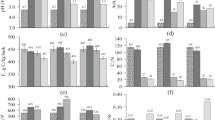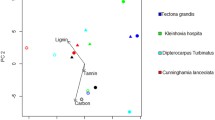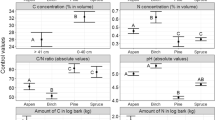Abstract
Under temperate climatic conditions, temperature is a key abiotic factor that controls the decomposition of coarse woody debris including bark. Using aspen bark (AB), we have carried out a 12-month laboratory experiment at three contrasting temperatures (2, 12, and 22°C) and constant sufficient moisture to quantify the temperature effect on the decomposition rate (DecR) and decay constant (k) of aspen bark. The effect of temperature on the total loss of C–CO2 and changes in the chemical composition of AB throughout the experiment are also estimated. An increase in the incubation temperature from 2 to 12°C and from 12 to 22°C induces a similar increase in the average (over 12 months) value of the DecR: the Q10 values are 1.30 and 1.41 in these temperature intervals, respectively. The most significant effect of temperature on the DecR dynamics is revealed during the 1st and 2nd months of the experiment. The maximum losses of C–CO2 (284 ± 16 mg C g bark–1, or 55.2 ± 3.2% of the initial C content) are observed at 22°C. The decay constants of AB, calculated by the one-component exponential model, significantly increase with the growth of the incubation temperature: from 0.46 ± 0.01 yr–1 at 2°C to 1.02 ± 0.09 yr–1 at 22°C. Changes in the chemical composition of aspen bark due to the processes of biogenic decomposition include a significant reduction in the amount of alcohol-soluble organic compounds and cellulose to 18–32 and 41–57% of their initial amount, respectively. Lignin losses are less significant, being only 9–18% of their content in AB before the incubation. The quantitative changes in the chemical composition of aspen bark are similar at 2 and 12°C and less pronounced than those at 22°C, which may be explained by an increase in the growing activity of organisms, are actively involved in bark decomposition at 22°C.





Similar content being viewed by others
REFERENCES
Berg, B., Litter decomposition and organic matter turnover in northern forest soils, For. Ecol. Manage., 2000, vol. 133, pp. 13–22.
Berg, B., Staaf, H., and Wessen, B., Decomposition and nutrient release in needle litter from nitrogen-fertilized Scots pine (Pinus silvestris) stands, Scand. J. For. Res., 1987, vol. 2, pp. 399–415.
Berglund, S.L., Ågren, G.I., and Ekblad, A., Carbon and nitrogen transfer in leaf litter mixtures, Soil Biol. Biochem., 2013, vol. 57, pp. 341–348.
Boddy, L., Interspecific combative interactions between wood-decaying basidiomycetes, FEMS Microb. Ecol., 2000, vol. 31, pp. 185–194.
Boddy, L. and Watkinson, S.C., Wood decomposition, higher fungi, and their role in nutrient redistribution, Can. J. Bot., 1995, vol. 73, pp. 1377–1383.
Bradford, M.A., Warren, R.J., Baldrian, P., Crowther, T.W., Maynard, D.S., Oldfield, E.E., Wieder, W.R., Wood, S.A., and King, J.R., Climate fails to predict wood decomposition at regional scales, Nat. Clim. Change, 2014, vol. 4, pp. 625–630.
Chambers, J.Q., Schimel, J.P., and Nobre, A.D., Respiration from coarse wood litter in central Amazon forests, Biogeochemistry, 2001, vol. 52, pp. 115–131.
Chen, H., Harmon, M.E., Griffiths, R.P., and Hicks, W., Effects of temperature and moisture on carbon respired from decomposing woody roots, For. Ecol. Manage., 2000, vol. 138, pp. 51–64.
Cornwell, W.K., Cornelissen, J.H.C., Allison, S.D., Bauhus, J., Eggleton, P., Preston, C.M., Scarff, F., Weedon, J.T., Wirth, C., and Zanne, A.E., Plant traits and wood fates across the globe: rotted, burned, or consumed? Global Change Biol., 2009, vol. 15, pp. 2431–2449.
Dence, C.W., The determination of lignin, in Methods of Lignin Chemistry, Lin, S.Y. and Dence, C.W., Eds., Berlin: Springer-Verlag. 1992, pp. 33–61.
Dossa, G.O., Paudel, E., Cao, K., Schaefer, D., and Harrison, R.D., Factors controlling bark decomposition and its role in wood decomposition in five tropical tree species, Sci. Rep., 2016, vol. 6, p. 34153.
Faustova, N.M., Chemical composition of bark and wood of European aspen Populus tremula L., Cand. Sci. (Chem.) Dissertation, St. Petersburg, 2005.
Forrester, J.A., Mladenoff, D.J., Gower, S.T., and Stoffel, J.L., Interactions of temperature and moisture with respiration from coarse woody debris in experimental forest canopy gaps, For. Ecol. Manage., 2012, vol. 265, pp. 124–132.
Franceschi, V.R., Krokene, P., Christiansen, E., and Krekling, T., Anatomical and chemical defenses of conifer bark against bark beetles and other pests, New Phytol., 2005, vol. 167, pp. 353–376.
Fukasawa, Y., The geographical gradient of pine log decomposition in Japan, For. Ecol. Manage., 2015, vol. 349, pp. 29–35.
Geles, I.S., Drevesnaya biomassa i osnovy ekologicheski priemlimykh tekhnologii ee khimiko-mekhaicheskoi pererabotki (Wood Biomass and Fundamentals of Ecology-Friendly Technologies of Its Chemical-Mechanical Processing), Petrozavodsk: Karel. Nauchn. Tsentr, Ross. Akad. Nauk, 2001.
Grishina, L.A., Koptsik, G.N., and Makarov, M.I., Transformatsiya orgnaicheskogo veshchestva pochv: Uchebnoe posobie (Transformation of Soil Organic Matter: Manual), Moscow: Mosk. Gos. Univ., 1990.
Hagemann, U., Moroni, M.T., Gleissner, J., and Makeschin, F., Disturbance history influences downed woody debris and soil respiration, For. Ecol. Manage., 2010, vol. 260, pp. 1762–1772.
Harmon, M.E., Franklin, J.F., Swanson, F.J., Sollins, P., Gregory, S.V., Lattin, N.G., Sedell, J.R., Lienkaemper, G.W., Cromack, K., Jr., and Cummins, K.W., Ecology of coarse woody debris in temperate ecosystems, Adv. Ecol. Res., 1986, vol. 15, pp. 133–302.
Hu, Z., Xu, C., McDowell, N.G., Johnson, D.J., Wang, M., Luo, Y., Zhou, X., and Huang, Z., Linking microbial community composition to C loss rates during wood decomposition, Soil Biol. Biochem., 2017, vol. 104, pp. 108–116.
Käärik, A.A., Decomposition of wood, in Biology of Plant Litter Decomposition, Dickinson, C.H. and Pugh, G.J.F., Eds., London: Academic, 1974, pp. 129–174.
Kahl, T., Arnstadt, T., Baber, K., Bässler, C., Bauhus, J., Borken, W., Buscot, F., Floren, A., Heibl, C., Hessenmöller, D., Hofrichter, M., Hoppe, B., Kellner, H., Krüger, D., Linsenmair, K.E., et al., Wood decay rates of 13 temperate tree species in relation to wood properties, enzyme activities and organismic diversities, For. Ecol. Manage., 2017, vol. 391, pp. 86–95.
Kapitsa, E.A., Trubitsyna, E.A., and Shorohova, E.V., Biogenic xylolysis of trunks, branches, and roots of forest-forming species of dark coniferous northern taiga, Lesovedenie, 2012, no. 3, pp. 51–58.
Kätterer, T., Reichstein, M., Andren, O., and Lomander, A., Temperature dependence of organic matter decomposition: a critical review using literature data analyzed with different model, Biol. Fertil. Soils, 1998, vol. 27, pp. 258–262.
Kazartsev, I., Shorohova, E., Kapitsa, E., and Kushnevskaya, H., Decaying Picea abies log bark hosts diverse fungal communities, Fungal Ecol., 2018, vol. 33, pp. 1–12.
Kuoki, J., Arnold, K., and Martikainen, P., Long-term persistence of aspen—a key host for many threatened species—is endangered in old-growth conservation areas in Finland, J. Nat. Conserv., 2004, vol. 12, pp. 41–52.
Kurganova, I.N., Lopes de Gerenyu, V.O., Gallardo Lancho, J.F., and Oehm, C.T., Evaluation of the rates of soil organic matter mineralization in forest ecosystems of temperate continental, Mediterranean, and tropical monsoon climates, Eurasian Soil Sci., 2012, vol. 45, no. 1, pp. 68–79.
Kurganova, I.N., Lopes de Gerenyu, V.O., Ableeva, V.A., and Bykhovets, S.S., Climate of southern Moscow region: modern trends and assessment of extreme conditions, Fundam. Prikl. Klimatol., 2017, no. 4, pp. 62–78.
Kurganova, I., Lopes de Gerenyu, V., Galibina, N., Kapitsa, E., and Shorohova, E., Coupled effect of temperature and mineral additions facilitates decay of aspen bark, Geoderma, 2018, vol. 316, pp. 27–37.
Kuznetsov, M.A., Influence of decomposition conditions and litter composition on the characteristics and reserves of litter in the middle taiga blueberry-sphagnum spruce forest, Lesovedenie, 2010, no. 6, pp. 54–60.
Larionova, A.A., Kvitkina, A.K., Bykhovets, S.S., Lopes de Gerenyu, V.O., Kolyagin, Yu.G., and Kaganov, V.V., Influence of nitrogen on mineralization and humification of forest litter in a model experiment, Lesovedenie, 2017a, no. 2, pp. 128–139.
Larionova, A.A., Maltseva, A.N., Lopes de Gerenyu, V.O., Kvitkina, A.K., Bykhovets, S.S., Zolotareva, B.N., and Kudeyarov, V.N., Effect of temperature and moisture on the mineralization and humification of leaf litter in a model incubation experiment, Eurasian Soil Sci., 2017b, vol. 50, no. 4, pp. 422–431.
Latva-Karjanmaa, T., Penttil, R., and Siitonen, J., The demographic structure of European aspen (Populus tremula) populations in managed and old-growth boreal forests in eastern Finland, Can. J. For. Res., 2007, vol. 37, no. 6, pp. 1070–1081.
Lestander, T.A., Holmberg, C., Stenberg, L., and Lehtonen, R., Towards multivariate statistical process control in the wood pellet industry, Biom. Bioeng., 2012, vol. 45, pp. 152–158.
Li, Q., Chen, J., and Moorhead, D.L., Respiratory carbon losses in a managed oak forest ecosystem, For. Ecol. Manage., 2012, vol. 279, pp. 1–10.
Liu W., Schaefer D., Qiao L., and Liu X., What controls the variability of wood-decay rates? For. Ecol. Manage., 2013, vol. 310, pp. 623–631.
Martin, A.R., Gezahegn, S., and Thomas, S.C., Variation in carbon and nitrogen concentration among major woody tissue types intemperate trees, Can. J. For. Res., 2015, vol. 45, pp. 744–757.
Mukhin, V.A., Biota ksilotrofnykh bazidiomitsetov Zapadno-Sibirskoi rabniny (Biota of Xylotrophic Basidiomycetes of West Siberian Plain), Yekaterinburg: Nauka, 1993.
Nikonova, L.G., Kurganova, I.N., Lopes de Gerenyu, V.O., Zhmurin, V.A., and Golovatskaya, E.A., Temperature effect on the decomposition rate of peat-forming plants: results of a model experiment, IOP Conf. Ser.: Earth Environ. Sci., 2018, vol. 211, art. ID 012037. https://doi.org/10.1088/1755-1315/211/1/012037
Nikonova, L.G., Kurganova, I.N., Lopes de Gerenyu, V.O., Zhmurin, V.A., and Golovatskaya, E.A., Influence of abiotic factors on the decomposition of litter of peat-forming plants in an incubation experiment, Vestn. Tomsk. Gos. Univ., Biol., 2019a, no. 46, pp. 148–170.
Nikonova, L.G., Golovatskaya, E.A., Kur’ina, I.V., and Kurganova, I.N., Decomposition rate of peat-forming plants in oligotrophic bogs of the southern taiga subzone of Western Siberia: assessment of the effect of water table level and peat deposit temperature, Eurasian Soil Sci., 2019b, vol. 52, no. 9, pp. 1101–1111
Obolenskaya, A.V., El’nitskaya, Z.P., and Leonovich, A.A., Laboratornye raboty po khimii drevesiny i tsellyulozy (Practical Manual on Chemistry of Wood and Cellulose), Moscow: Ekologiya, 1991.
Ohtsuka, T., Shizu, Y., Hirota, M., Yashiro, Y., Shugang, J., Iimura, Y., and Koizumi, H., Role of coarse woody debris in the carbon cycle of Takayama forest, central Japan, Ecol. Res., 2014, vol. 29, pp. 91–101.
Olajuyigbe, S., Tobin, B., and Nieuwenhuis, M., Temperature and moisture effects on respiration rate of decomposing logs in a Sitka spruce plantation in Ireland, Forestry, 2012, vol. 85, no. 4, pp. 485-496.
Olson, J., Energy storage and the balance of producers and decomposers in ecological systems, Ecology, 1963, vol. 44, no. 2, pp. 322–331.
Palviainenm, M., Laiho, R., Mäkinen, H., and Finér, L., Do decomposing Scots pine, Norway spruce, and silver birch stems retain nitrogen? Can. J. For. Res., 2008, vol. 38, no. 12, pp. 3047–3055.
Russell, M.B., Fraver, S., Aakala, T., Gove, J.H., Woodall, C.W., D’Amato, A.W., and Ducey, M.J.T., Quantifying carbon stores and decomposition in dead wood: a review, For. Ecol. Manage., 2015, vol. 350, pp. 107–128.
Safronov, M.A., Bulgakov, E.A., Ostapenko, A.V., and Tyapukhin, P.V., The influence of wood destruction on the temperature and humidity regime in forest biogeocenoses of the southern Urals, Vestn. Orenb. Gos. Univ., 2013, no. 10 (159), pp. 333–335.
Semenov, V.M. and Khodzhaeva, A.K., Agroecological functions of plant remains in soil, Agrokhimiya, 2006, no. 7, pp. 63–81.
Shorohova, E. and Kapitsa, E., Stand and landscape scale variability in the amount and diversity of coarse woody debris in primeval European boreal forests, For. Ecol. Manage., 2015, vol. 315, pp. 185–190.
Shorohova, E. and Kapitsa, E., The decomposition rate of non-stem components of coarse woody debris (CWD) in European boreal forests mainly depends on site moisture and tree species, Eur. J. For. Res., 2016, vol. 135, pp. 593–606.
Shorohova, E., Ignatyeva, O., Kapitsa, E., Kauhanen, H., Kuznetsov, A., and Vanha-Majamaa, I., Stump decomposition rates after clear-felling with and without prescribed burning in southern and northern boreal forests in Finland, For. Ecol. Manage., 2012, vol. 263, pp. 74–84.
Shorohova, E., Kapitsa, E., Kazartsev, I., Romashkin, I., Polevoi, A., and Kushnevskaya, A., Tree species traits are the predominant control on the decomposition rate of tree log bark in a mesic old-growth boreal forest, For. Ecol. Manage., 2016, vol. 377, pp. 36–45.
Sinsabaugh, R.L., Antibus, R.K., Linkins, A.E., McClaugherty, C.A., Rayburn, L., Repert, D., and Weiland, T., Wood decomposition: nitrogen and phosphorus dynamics in relation to extracellular enzyme activity, Ecology, 1993, vol. 74, pp. 1586–1593.
Skonieczna, J., Małek, S., Polowy, K., and Węgiel, A., Elements content of Scots pine (Pinus sylvestris L.) stands of different densities, Drewno Pr. Nauk. Doniesienia Komunikaty, 2014, vol. 57, no. 192, pp. 77–87.
Taylor, B.R. and Parkinson, D., Aspen and pine leaf litter decomposition in laboratory microcosms. II. Interactions of temperature and moisture level, Can. J. Bot., 1988, vol. 66, pp. 1966–1973.
Ugolev, B.N., Drevesinovedenie i lesnoe tovarovedenie. Uchebnoe posobie (Wood Science and Forest Commodity Research: Manual), Moscow: Mosk. Gos. Univ. Lesa, 2002.
Ul’yanova, O.A. and Chuprova, V.V., Mineralization of the bark of various of tree species and fertilizer compositions based on it, Agrokhimiya, 2015, no. 2, pp. 33–45.
Vedrova, E.F., Organic matter decomposition in forest litters, Eurasian Soil Sci., 1997, vol. 30, no. 2, pp. 181–188.
Wetzel, S. and Greenwood, J.S., Proteins as a potential nitrogen storage compound in bark and leaves of several softwoods, Trees, 1989, vol. 3, pp. 149–153.
Winckler, J.P., Cherry, R.S., and Schlesinger, W.H., The Q 10 relationship of microbial respiration in a temperate forest soil, Soil Biol. Biochem., 1996, vol. 28, no. 8, pp. 1067–1072.
Worrell, R., European aspen (Populus tremula): a review with particular reference to Scotland 1: Distribution, ecology and genetic variation, Forestry, 1995a, vol. 68, pp. 94–105.
Worrell, R., European aspen (Populus tremula): a review with particular reference to Scotland, 2: Values, silviculture and utilization, Forestry, 1995b, vol. 68, pp. 231–244.
Wu, J., Zhang, X., Wang, H., Sun, J., and Guan, D., Respiration of downed logs in an old-growth temperate forest in north-eastern China, Scand. J. For. Res., 2010, vol. 25, pp. 500–506.
Yatskov, M., Harmon, M.E., and Krankina, O.N., A chronosequence of wood decomposition in the boreal forests on Russia, Can. J. For. Res., 2003, vol. 33, pp. 1211–1226.
Zamolodchikov, D.G., Evaluation of carbon pool of large wood remains in Russian forests taking into account the impact of wild fires and logging, Lesovedenie, 2009, no. 4, pp. 3–15.
Zhang, D., Hui, D., Luo, Y., and Zhou, G., Rates of litter decomposition in terrestrial ecosystems: global patterns and controlling factors, J. Plant Ecol., 2008, vol. 1, pp. 85–93.
Zhou, L., Dai, L., Gu, H., and Zhong, L., Review on the decomposition and influence factors of coarse woody debris in forest ecosystem, J. For. Res., 2007, vol. 18, no. 1, pp. 48–54.
Funding
This study was performed under the State Assignment of the Puschino Biological Research Center, Russian Academy of Sciences, project no. AAAA-A18-118013190177-9, and State Assignment of the Karelian Research Center, Russian Academy of Sciences, and supported by the Russian Foundation for Basic Research, project no. 19-04-01282a.
Author information
Authors and Affiliations
Corresponding author
Ethics declarations
Conflict of interests. The authors declare that they have no conflicts of interest.
Statement on the welfare of humans or animals. This article does not contain any studies involving animals performed by any of the authors.
Additional information
Translated by D. Zabolotny
Rights and permissions
About this article
Cite this article
Kurganova, I.N., Lopes de Gerenyu, V.O., Galibina, N.A. et al. Effect of Temperature on the Intensity of the Biogenic Decomposition of Aspen Bark. Contemp. Probl. Ecol. 13, 663–673 (2020). https://doi.org/10.1134/S1995425520060086
Received:
Revised:
Accepted:
Published:
Issue Date:
DOI: https://doi.org/10.1134/S1995425520060086




